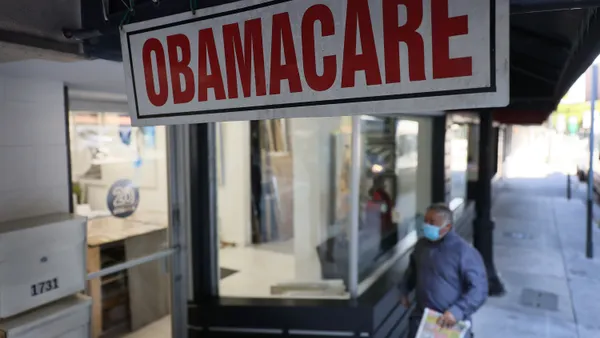Dive Brief:
- Molina cut its 2025 earnings guidance for the third time this year on Wednesday, citing doggedly high medical costs particularly in its Affordable Care Act plans.
- The insurer now projects adjusted earnings per share of $14 this year, down from its prior estimate of “no less than” $19 from July. The earnings reduction is despite Molina now believing it will bring in higher premiums this year.
- Molina also posted third quarter results on Wednesday that beat analyst expectations on revenue but missed on earnings. The insurer’s stock plummeted 19% in aftermarket trading following the results.
Dive Insight:
Close followers of insurers’ recent financial quarters know this story well. Payers are slogging through a difficult time, absorbing elevated medical spending from their members. The utilization pressure is particularly acute in government programs, making the trend more challenging for insurers without other businesses to fall back upon.
Molina, which covers 5.6 million members in Medicaid, Medicare and ACA marketplace plans, is one such insurer.
And now, the California-based company is lowering its profit guidance for 2025 once again, despite upwardly revising its expectations for premium revenue this year.
Medical cost growth was apparent in all of Molina’s business segments, but disproportionately high in the ACA marketplaces. CEO Joe Zubretsky called the ACA trend “unprecedented” during a Thursday morning call with investors.
The ACA is Molina’s second-largest business behind Medicaid, accounting for roughly one-tenth of its members and premium revenue. Last year, Molina grew its ACA presence for 2024, a move that appeared shrewd at the time given that the ACA exchanges appeared insulated from the costs hitting Medicaid and Medicare Advantage. However, the strategy has come back to bite the insurer, as the members it added for 2025 came saddled with higher costs themselves.
The problem isn’t unique to Molina. There’s been a market-wide increase in enrollees’ health needs that has outpaced checks and balances against spiking costs in the ACA risk pools.
“Our marketplace business has significantly underperformed our expectations but its performance appears consistent with industry-wide trends,” Zubretsky said.
The exchange pressures are evident in Molina’s medical loss ratio, a metric that represents spending on patient care as a percentage of overall premiums. MLRs are closely watched by investors since even small variations can have major implications on insurers’ profitability.
Overall, Molina posted a medical loss ratio of 92.6% in the quarter, up from 89.2% same time last year.
However, its MLR for ACA plans hit 95.6%, up from 73% same time last year. That’s an increase of 2,260 basis points, or 22.6 percentage points, year over year — a jump TD Cowen analyst Ryan Langston called “staggering” in a note on the results.
Overall, the results indicate that Molina’s ACA business will lose money this year, to the tune of low- to mid-single digit negative margins, analysts said.
As for Molina’s other businesses in the quarter, Medicaid margins were “strong” but pressured from continued utilization, Zubretsky said. Similarly, Molina’s Medicare members continue to utilize more and pricier medical care, especially high-acuity members in the areas of long-term supports and services and prescription drugs.
Molina’s net income fell 76% year over year to $79 million in the quarter, according to financial documents. That’s despite an 11% increase in revenue to $11.5 billion.
Molina executives argued the company’s margin challenges will be temporary, with Zubretsky characterizing the current environment as “inclement weather, rather than climate change.”
But volatility in the ACA exchanges is only expected to worsen next year, given the looming expiration of more generous subsidies for marketplace plans. Congress is currently deadlocked on whether or not to extend the financial assistance, an impasse that’s creating the government shutdown. Without the higher subsidies, millions of Americans are expected to be priced out of the exchanges, likely leaving those remaining sicker and even more costly.
Insurers have hiked their premiums for 2026 as a result — including Molina. The payer increased prices for its 2026 ACA plans by an average of 30%, according to CFO Mark Keim.
Molina also exited underperforming plans, reducing its county footprint by one-fifth, Keim said. The actions should improve Molina’s margins. But the insurer is open to leaving the ACA exchanges entirely in the future if the risk pool doesn’t stabilize, Zubretsky suggested.
“While other market participants might consider this product a necessity we consider it an option,” the CEO said during the call.
It’s too early for Molina to give formal guidance on next year. However, the insurer said it expects its 2026 adjusted earnings to be roughly the same as its new $14 per-share guidance.
One bright spot is that Medicaid payment rates should continue to increase as states receive more data about current medical trend, and incorporate it into plans’ reimbursement. Membership impacts from Medicaid cuts in the GOP’s budget bill passed this summer also shouldn’t hit until 2027 or 2028, executives said.
But given the ongoing pressures, Molina’s ability to achieve its flat forecast “takes some faith,” Jefferies analyst David Windley wrote in a note Wednesday.
Molina is the latest insurer to suggest payers’ woes are unlikely to dissipate next year. Earlier this week, Elevance implied that its profits will shrink in 2026, particularly in Medicaid.















